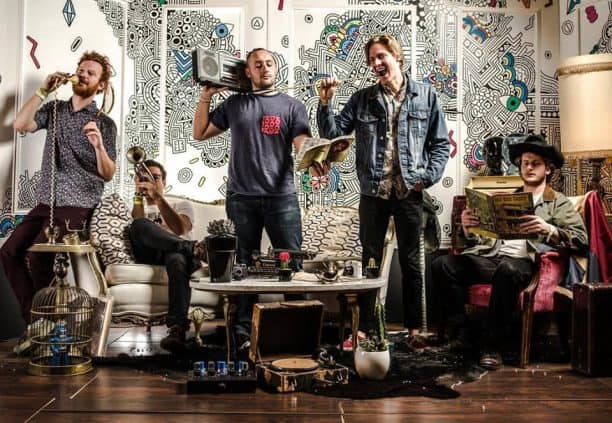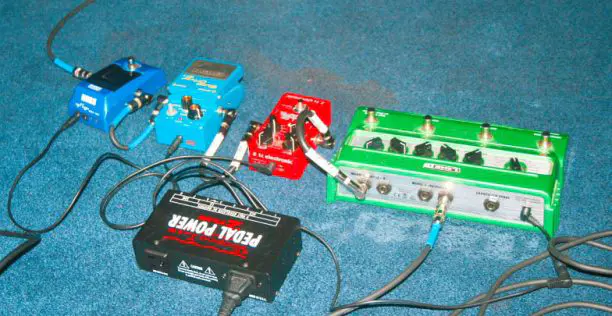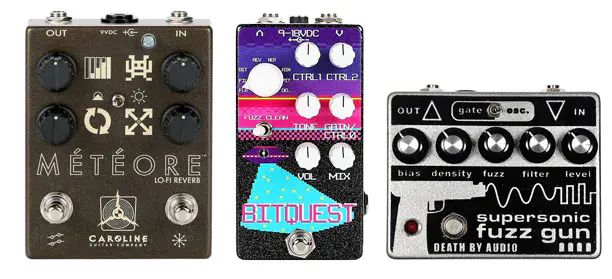
After the initial warped drum beat, it only takes 8 seconds for Future Generations to kick in to full alt-pop shine on new single “All The Same.” The track is the first from the Brooklyn group’s newly announced sophomore album, Landscape, out September 13 via Frenchkiss Records. “All The Same” moves Future Generation’s sleek alt-pop into more synth and electronics heavy sounds than the band’s 2016 self-titled full-length. The highlight of the song comes in the form of a arpeggiated synth melody that floats the chorus. We asked the band a few questions about what went into the upcoming record, both in terms of inspiration and gear. – Cameron Carr
What feelings, people, places, events and/or records have been inspiring your sophomore album “Landscape”?
This album is a culmination of about two years of growth in every aspect of our lives. We have all grown in our relationships with each other, with others, whether they are romantic or otherwise, in our determination, and in our songwriting. This album is about experiencing these new things and learning to cope with them and the self-dialogue that goes into figuring out how to best move forward in life. From a songwriting standpoint, we really wanted to challenge ourselves. We have always gravitated towards pop as a medium for our songs, but we strived to make the sounds and arrangements of these songs unique. Of course, we had all types of influences, Sylvan Esso, Hippo Campus, Rostam and Fall Out Boy to name a few, and their marks can definitely be heard on this record, but we really just wanted to make something new that we haven’t heard before.
What are the role and dynamics in the band in the creative process?
Even though we fall into certain roles, the creation process is very democratic, and everyone winds up doing a little bit of everything.
Does gear have a role in this process? If so how?
Absolutely! We always write the music before the lyrics. We don’t have a lot of gear but the gear we do have definitely informs our writing process. We don’t start with a chord progression, we usually start with a sound, whether it’s a drum sample or a synth. The characteristics of those sounds inform the type of chord progression we play, melody line, and mood of the song. The gear we have access to since we do a lot of pre-production at home defines our sound for sure.
I noticed you have a “laptop player” in some of your live videos, what is he running on it?
Mike: Yup, that’s me. I’m running Microsoft Excel. Also, Ableton Live! When the band first started, I was using my MPC1000, with 50 something seconds of sample time and busted pads, for live shows – a disaster. Ableton Live has genuinely improved my quality of life and stress levels. I use the session view for live sets. I run a mixture of clips using follow action and drum racks preloaded with samples triggered by an Akai MPD for each song. I always opt to work with audio clips over VST [plugins]; it keeps my CPU low and my Ableton set stable.
Were there any instruments or pieces of gear that were particularly inspiring in the making of this record?
My favorite piece of gear was the BOSS SP-303 sampler (pictured). I had been familiar with the 303 and its family thru the beat scene community, but had never used one. Dylan Herman, the fantastic studio assistant, brought his in and we were blown away. I couldn’t believe it’s versatility and usability in a more pop-oriented context. We ran so many instruments thru it, particularly using it’s built-in compressor and vinyl sim effects. I ran to the Guitar Center on Atlantic Ave the day after Dylan brought his to the studio and bought one :D.

Eddie: I have typically used a lot of software synths in our music production. One of the most used soft synths was a free OB-X emulator called OBXD by Datsounds. So many lush pads and sparkly lead lines from this thing. We also used Fabfilter’s Saturn saturator plug-in on a lot of sounds to give depth and grit. From a hardware standpoint one of the surprise All-Stars of this record was a little organ/synth called the Fun Machine. It is all over this album, and its name could not be more appropriate. Sometimes you can’t beat the sound of an analog instrument. The Line 6 DL4 guitar pedal combined with the Dr. Scientist BitQuest also played a huge role in creating some of the more unique sounds on the record. If you’re listening to the album and you’re like “how did they make that sound?” it’s probably from one of those two pedals. We recorded tons and tons of rambling guitar (and sometimes synth) lines and went through and picked out some of the best material to insert as auxiliary sounds.
Mike: Ableton’s warping features are next level and were my go-to for manipulation, pitching, and stretching sounds. I had a drum circle recording I had done with friends a few months before recording, and a lot of that percussion got cut up in Ableton and found their way into the tracks (Stranger, All The Same, I Never Knew I Was Lonely, Tear You Down).
What other synths and effects did you abuse of in the studio?
Fabfilter One, Native Instruments Kontakt, Green Oak Crystal, Juno 106, Baldwin Fun Machine, Yamaha VSS-30, Yamaha PS-30.
The record has a variety of guitar sounds, what’s on your guitarist’s pedalboard?
Eric This is our bare bones live rig, NO BOARD pedalboard:

I typically run through just a DL4 delay, TC Hall of Fame reverb, + Boss Blues Driver for live stuff, but in the studio, it’s expanded quite a bit. Typically we had the DL4 as the base to create textures and fiddle around from there by adding + subtracting pedals. Usually, I’ll create a loop (with either one or multiple parts) and reverse and speed it up. Then we either slap the loop right in a song or chop it up and plop it in. You can hear that in songs like Tear You Down (the repetitive guitar part in the chorus was actually played at half that speed) and pretty much on almost every other song. To get a bit weirder, we’d run the guitar loops through a reverb like the Caroline Guitar Co. Meteore or through the legendary Dr. Scientist Bitquest, a super wild multi-effect pedal from Canada. In Hurry Home, for instance, those weird swirly distorted noises are both guitars and the fun machine run through the Bitquest’s manual pitch shifter. Another fun and #local pedal we used was the Death By Audio Supersonic Fuzz Gun. That thing is ZANY! We used its oscillation mode on the end of the track Landscape. It’s basically just never-ending fuzz that dips and dives in pitch, a solid tool for blowing speakers. We also ran my guitar through a Guild Echorec a few times as well to get some of the echo sounds. You can hear that in the sustained guitar strokes at the end of All The Same.

Is there a person outside the band that’s been important in perfecting your recorded and/or live sound?
We could rave all day about our producer Justin Gerrish and his assistant Dylan Herman. They really helped us hone in on our sound and transform our demos into finished songs. They had some really great ideas and never hesitated to try anything, despite how unusual. For example, in Tear You Down, Dylan was messing with the Fun Machine’s built-in drum machine. But instead of keeping the tempo constant, he was drastically twisting the tempo knob, making it sound like a drummer doing drum rolls on a snare.
What other emerging NYC artists are you enjoying these days?
Active Bird Community, Caleb Giles, Crumb, Ghost King, Lewis Del Mar, Medhane, MIKE, Modern Diet, pronoun, Ritual Talk, Standing on The Corner, Palberta, Petite League, Shilpa Rey, YL, Yucky Duster, Zuli.






















